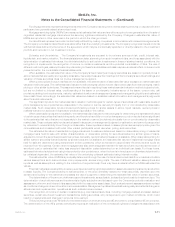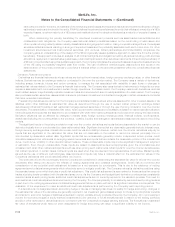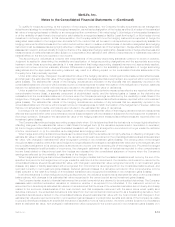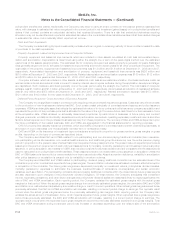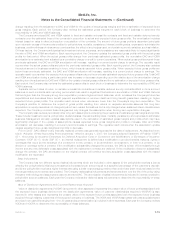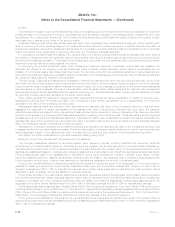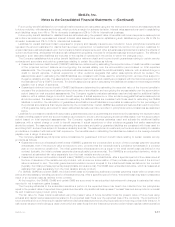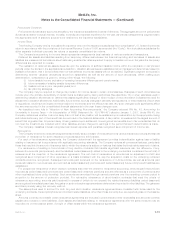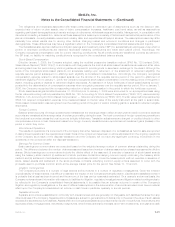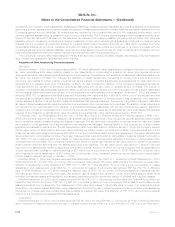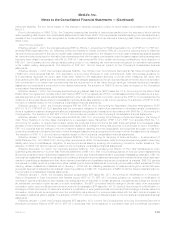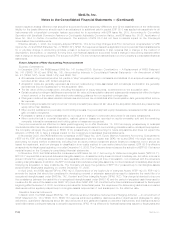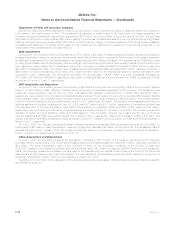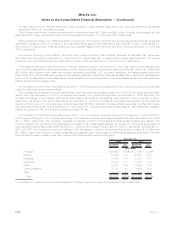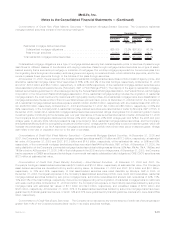MetLife 2008 Annual Report Download - page 144
Download and view the complete annual report
Please find page 144 of the 2008 MetLife annual report below. You can navigate through the pages in the report by either clicking on the pages listed below, or by using the keyword search tool below to find specific information within the annual report.The obligations and expenses associated with these plans require an extensive use of assumptions such as the discount rate,
expected rate of return on plan assets, rate of future compensation increases, healthcare cost trend rates, as well as assumptions
regarding participant demographics such as rate and age of retirements, withdrawal rates and mortality. Management, in consultation with
its external consulting actuarial firm, determines these assumptions based upon a variety of factors such as historical performance of the
plan and its assets, currently available market and industry data, and expected benefit payout streams. The assumptions used may differ
materially from actual results due to, among other factors, changing market and economic conditions and changes in participant
demographics. These differences may have a significant effect on the Company’s consolidated financial statements and liquidity.
The Subsidiaries also sponsor defined contribution savings and investment plans (“SIP”) for substantially all employees under which a
portion of employee contributions are matched. Applicable matching contributions are made each payroll period. Accordingly, the
Company recognizes compensation cost for current matching contributions. As all contributions are transferred currently as earned to
the SIP trust, no liability for matching contributions is recognized in the consolidated balance sheets.
Stock-Based Compensation
Effective January 1, 2006, the Company adopted, using the modified prospective transition method, SFAS No. 123 (revised 2004),
Share-Based Payment (“SFAS 123(r)”). In accordance with this guidance the cost of all stock-based transactions is measured at fair value
and recognized over the period during which a grantee is required to provide goods or services in exchange for the award. Although the
terms of the Company’s stock-based plans do not accelerate vesting upon retirement, or the attainment of retirement eligibility, the
requisite service period subsequent to attaining such eligibility is considered nonsubstantive. Accordingly, the Company recognizes
compensation expense related to stock-based awards over the shorter of the requisite service period or the period to attainment of
retirement eligibility. Prior to January 1, 2006, the Company recognized stock-based compensation over the vesting period of the grant or
award, including grants or awards to retirement-eligible employees. An estimation of future forfeitures of stock-based awards is incor-
porated into the determination of compensation expense when recognizing expense over the requisite service period. Prior to January 1,
2006, the Company recognized the corresponding reduction of stock compensation in the period in which the forfeitures occurred.
Stock-based awards granted after December 31, 2002 but prior to January 1, 2006 were accounted for on a prospective basis using
the fair value accounting method prescribed by SFAS No. 123, Accounting for Stock-Based Compensation (“SFAS 123”), as amended by
SFAS No. 148, Accounting for Stock-Based Compensation — Transition and Disclosure (“SFAS 148”). The fair value method prescribed by
SFAS 123 required compensation expense to be measured based on the fair value of the equity instrument at the grant or award date.
Stock-based compensation was recognized over the vesting period of the grant or award, including grants or awards to retirement-eligible
employees.
Foreign Currency
Balance sheet accounts of foreign operations are translated at the exchange rates in effect at each year-end and income and expense
accounts are translated at the average rates of exchange prevailing during the year. The local currencies of foreign operations generally are
the functional currencies unless the local economy is highly inflationary. Translation adjustments are charged or credited directly to other
comprehensive income or loss. Gains and losses from foreign currency transactions are reported as net investment gains (losses) in the
period in which they occur.
Discontinued Operations
The results of operations of a component of the Company that either has been disposed of or is classified as held-for-sale are reported
in discontinued operations if the operations and cash flows of the componenthavebeenorwillbeeliminatedfromtheongoingoperations
of the Company as a result of the disposal transaction and the Company will not have any significant continuing involvement in the
operations of the component after the disposal transaction.
Earnings Per Common Share
Basic earnings per common share are computed based on the weighted average number of common shares outstanding during the
period. The difference between the number of shares assumed issued and number of shares assumed purchased represents the dilutive
shares. Diluted earnings per common share include the dilutive effect of the assumed: (i) exercise or issuance of stock-based awards
using the treasury stock method; (ii) settlement of stock purchase contracts underlying common equity units using the treasury stock
method; and (iii) settlement of accelerated common stock repurchase contract. Under the treasury stockmethod,exerciseorissuanceof
stock- based awards and settlement of the stock purchase contracts underlying common equity units is assumed to occur with the
proceeds used to purchase common stock at the average market price for the period. See Notes 13, 18 and 20.
Litigation Contingencies
The Company is a party to a number of legal actions and is involved in a number of regulatory investigations. Given the inherent
unpredictability of these matters, it is difficult to estimate the impact on the Company’s financial position. Liabilities are established when it
is probable that a loss has been incurred and the amount of the loss can be reasonably estimated. On a quarterly and annual basis, the
Company reviews relevant information with respect to liabilities for litigation, regulatory investigations and litigation-related contingencies to
be reflected in the Company’s consolidated financial statements. It is possible that an adverse outcome in certain of the Company’s
litigation and regulatory investigations, or the use of different assumptions in the determination of amounts recorded could have a material
effect upon the Company’s consolidated net income or cash flows in particular quarterly or annual periods.
Separate Accounts
Separate accounts are established in conformity with insurance laws and are generally not chargeable with liabilities that arise from any
other business of the Company. Separate account assets are subject to general account claims only to the extent the value of such assets
exceeds the separate account liabilities. Assets within the Company’s separate accounts primarily include: mutual funds, fixed maturity and
equity securities, mortgage loans, derivatives, hedge funds, other limited partnership interests, short-term investments, and cash and cash
F-21MetLife, Inc.
MetLife, Inc.
Notes to the Consolidated Financial Statements — (Continued)


